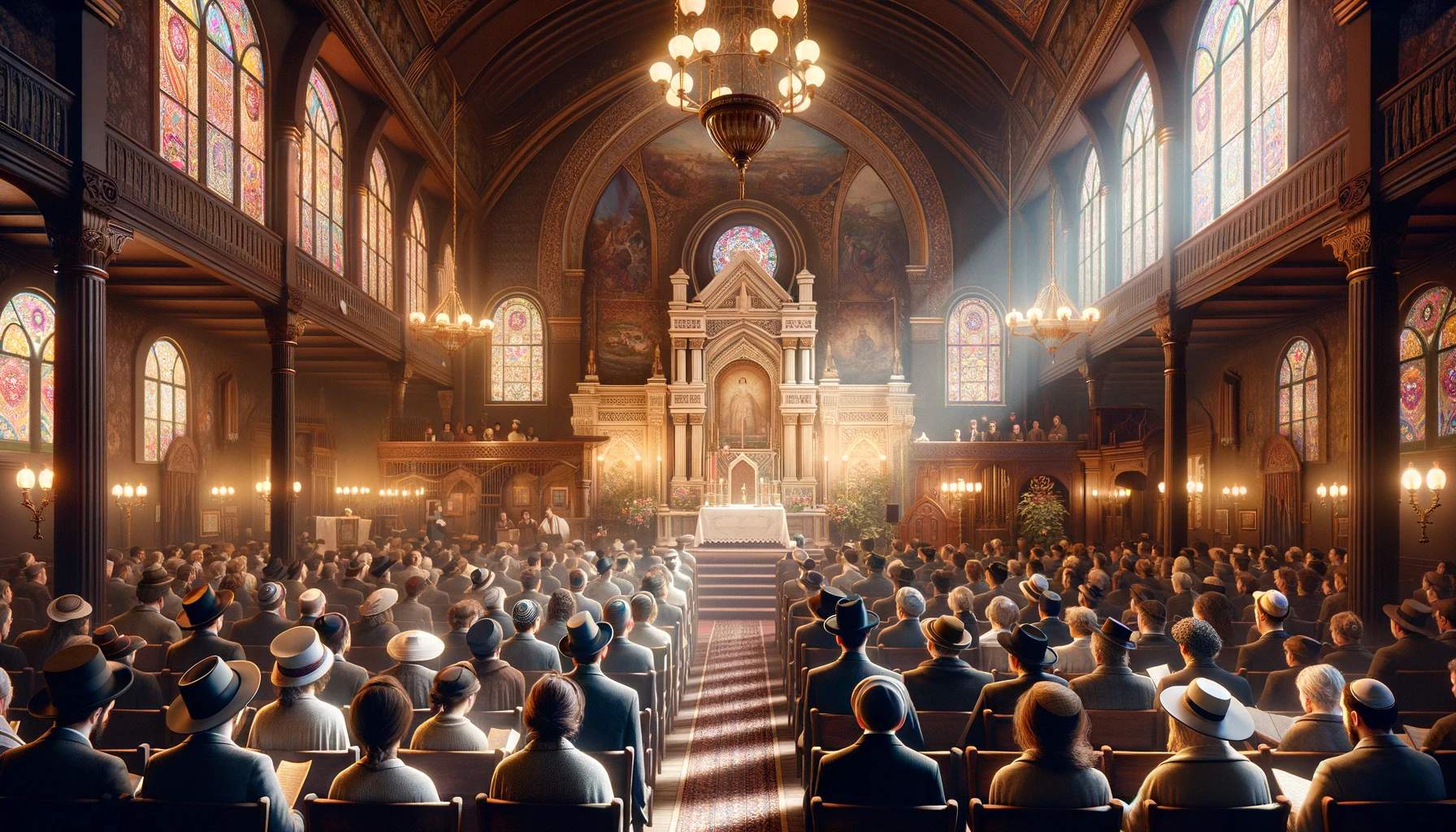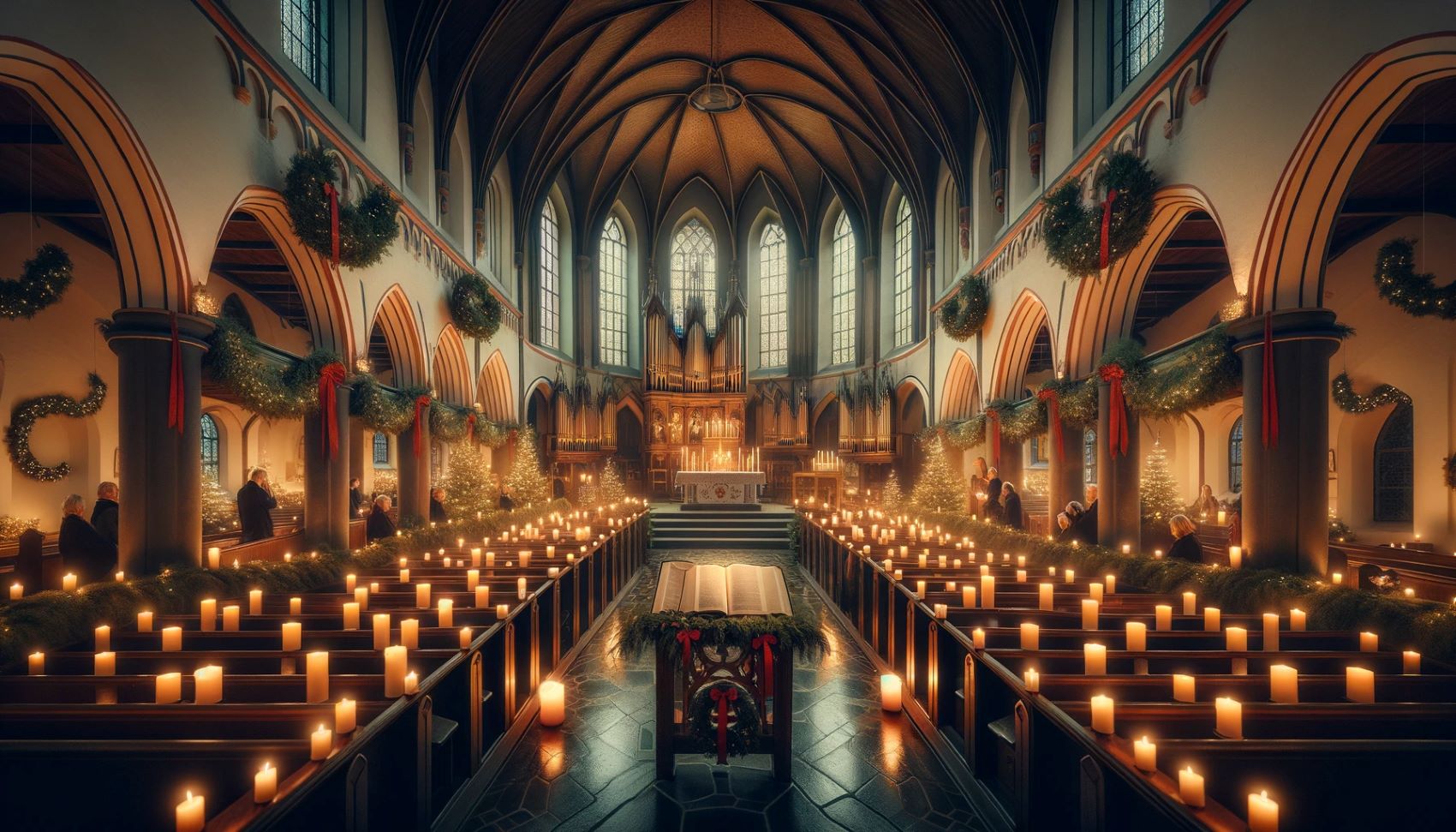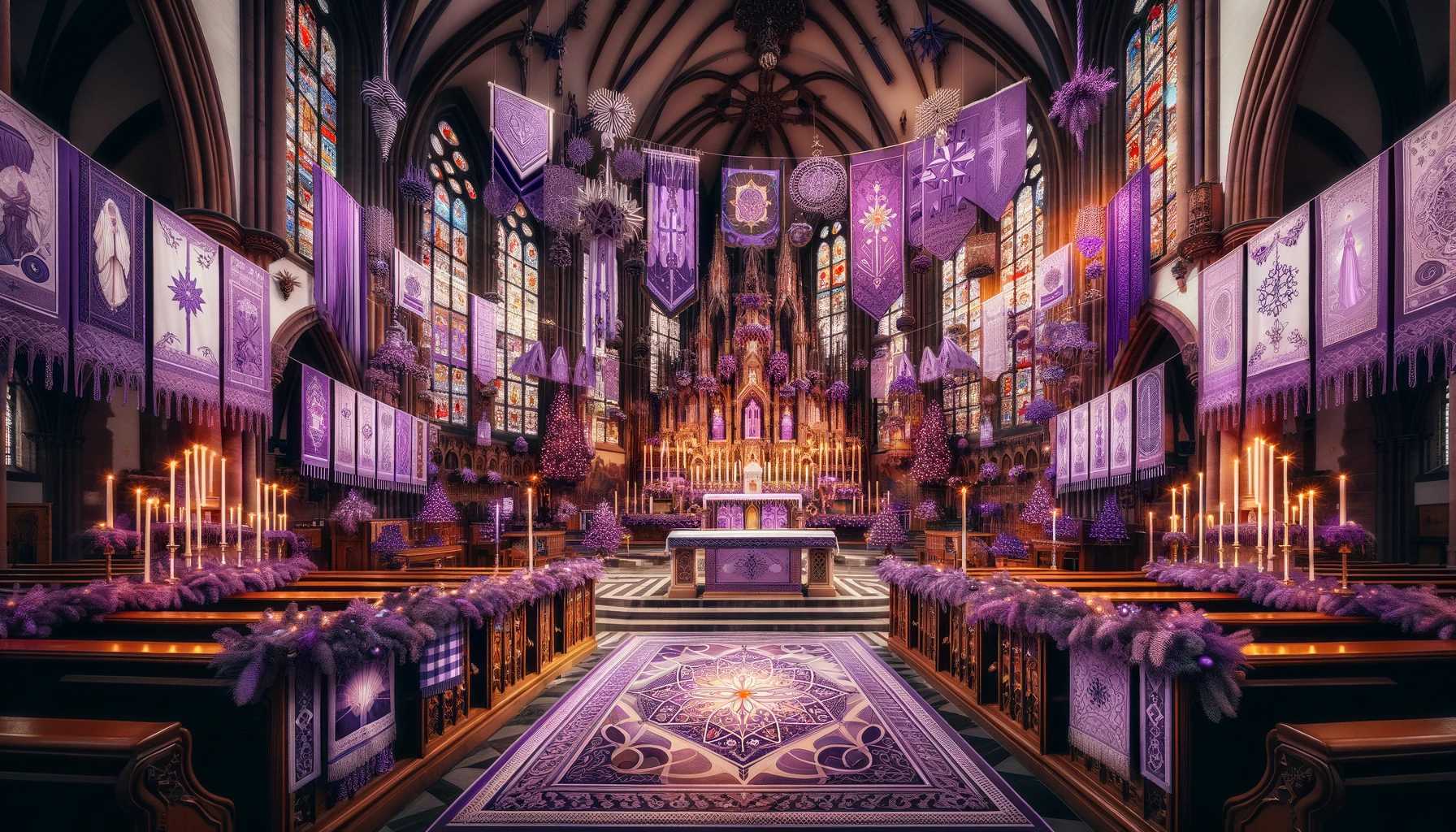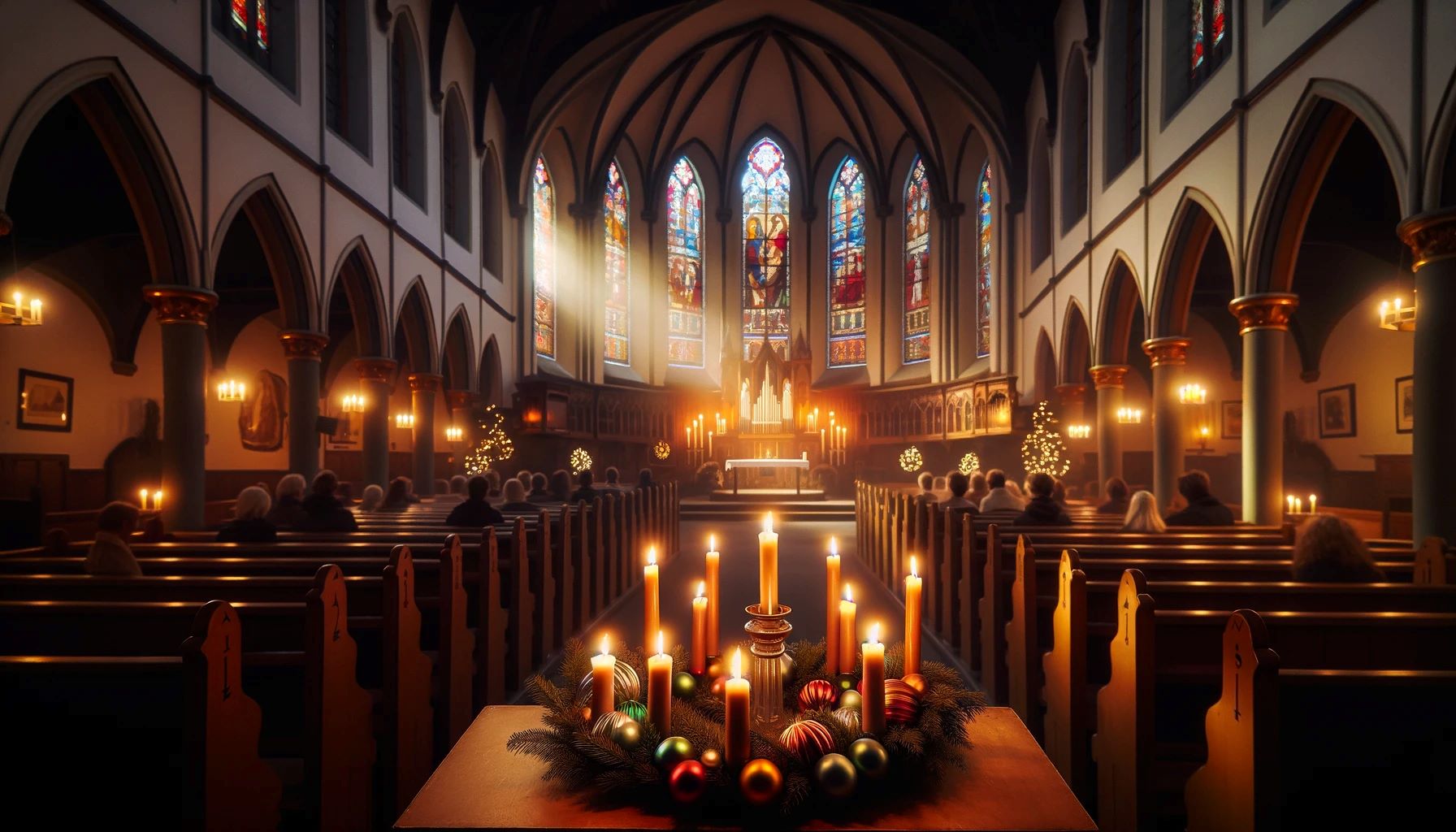Home>Special Themes>What Are Some Advent Traditions


Special Themes
What Are Some Advent Traditions
Published: February 12, 2024
Peter Smith, Editorial Director at Christian.net, combines deep insights into faith, politics, and culture to lead content creation that resonates widely. Awarded for his contributions to religious discourse, he previously headed a major organization for religious communicators, enhancing dialogue on faith's societal impacts.
Discover special themes and traditions for celebrating Advent. Explore unique ideas for creating meaningful and memorable experiences during this festive season.
(Many of the links in this article redirect to a specific reviewed product. Your purchase of these products through affiliate links helps to generate commission for Christian.net, at no extra cost. Learn more)
Table of Contents
Introduction
Advent, derived from the Latin word "adventus," meaning "coming" or "arrival," is a significant season observed in many Christian traditions. It marks the period of spiritual preparation and anticipation leading up to the celebration of the birth of Jesus Christ on Christmas Day. This sacred time typically begins on the fourth Sunday before Christmas and is a time of reflection, hope, and joyful expectation.
During Advent, believers are encouraged to engage in practices that foster a deeper connection to the spiritual significance of Christmas. These traditions vary across different cultures and denominations, but they all share the common goal of preparing hearts and minds to celebrate the birth of Jesus.
The Advent season serves as a reminder of the anticipation felt by the ancient Israelites as they awaited the arrival of the Messiah. It also symbolizes the hope and longing for the second coming of Christ, emphasizing the dual nature of Advent as a time of both historical reflection and future expectation.
As the world around us becomes increasingly fast-paced and commercialized during the holiday season, Advent offers a counter-cultural invitation to slow down, reflect, and embrace the spiritual essence of Christmas. It provides an opportunity for individuals and families to engage in meaningful traditions that emphasize faith, love, joy, and peace.
Throughout the centuries, various customs and rituals have emerged to enrich the observance of Advent. These traditions, ranging from the lighting of Advent candles to the creation of Jesse Trees, serve as tangible expressions of faith and devotion. They create a sense of continuity with the past while nurturing a sense of community and shared spiritual journey in the present.
In the following sections, we will explore some of the most cherished Advent traditions, each carrying its own rich symbolism and significance. These traditions not only deepen the spiritual experience of Advent but also foster a sense of unity and purpose within the global Christian community. As we delve into these timeless practices, may we find inspiration and renewed meaning in the anticipation of the coming of Christ.
Read more: Where Did The Tradition Of Advent Come From
Advent Wreath
The Advent wreath, with its timeless symbolism and profound significance, stands as a cherished emblem of the Advent season. This iconic tradition traces its roots to 16th-century Germany, where it was initially crafted using a simple wooden wheel adorned with evergreen foliage. Over time, the Advent wreath has evolved into a powerful visual representation of the anticipation and preparation for the coming of Christ.
Typically, the Advent wreath consists of a circular arrangement of evergreen branches, symbolizing eternal life and the unending love of God. The circular shape itself represents the unbroken nature of God's love and the eternal nature of the divine. Additionally, the wreath often features four candles, each representing one of the four weeks of Advent.
The lighting of the Advent wreath candles is a central ritual in many Christian households and congregations during the Advent season. The first candle, known as the "Prophet's Candle" or "Hope Candle," is lit on the first Sunday of Advent, signifying the hope and anticipation of the coming Messiah. The second candle, often referred to as the "Bethlehem Candle" or "Preparation Candle," is lit on the second Sunday, symbolizing the preparation for the birth of Jesus.
On the third Sunday of Advent, the "Shepherd's Candle" or "Joy Candle" is lit, representing the joy brought by the anticipation of Christ's birth. Finally, the fourth candle, known as the "Angel's Candle" or "Love Candle," is lit on the fourth Sunday, signifying the love and peace brought by the arrival of the Christ child.
In some traditions, a fifth candle, known as the "Christ Candle," is placed in the center of the wreath and lit on Christmas Eve or Christmas Day, symbolizing the arrival of Christ as the light of the world. This culminating act serves as a poignant reminder of the fulfillment of the long-awaited promise of salvation.
The Advent wreath, with its evocative symbolism and ritualistic lighting of candles, serves as a powerful focal point for personal and communal reflection during the Advent season. It provides a visual and tactile means of marking the passage of time and nurturing a sense of spiritual anticipation and hope. As families and congregations gather around the glowing wreath, the soft illumination of the candles becomes a tangible representation of the increasing light and hope brought by the imminent arrival of Christ.
In essence, the Advent wreath encapsulates the essence of the Advent season, inviting individuals to engage in a journey of spiritual preparation, reflection, and joyful expectation. It serves as a timeless reminder of the enduring hope, love, joy, and peace that Christ's birth brings to the world, transcending time and culture to unite believers in a shared celebration of faith and anticipation.
Advent Calendar
The Advent calendar, a beloved tradition with origins dating back to 19th-century Germany, has become an integral part of the Advent season for many families and communities around the world. This cherished custom serves as a tangible and joyful way to count down the days leading up to Christmas while embracing the spiritual significance of the season.
Traditionally, an Advent calendar consists of a decorative, often festive, display featuring numbered doors or compartments, each corresponding to a specific day in December leading up to Christmas Eve. These doors are meant to be opened, one per day, unveiling a hidden surprise or treat within. While modern Advent calendars may take various forms, from traditional paper designs to innovative digital versions, the underlying purpose remains the same: to cultivate a sense of anticipation and wonder as each day brings the joyful revelation of a new symbol, scripture, or small gift.
The Advent calendar serves as a delightful and interactive means of engaging with the Advent season, particularly for children. It fosters a sense of eager anticipation and daily reflection on the spiritual themes of hope, love, joy, and peace. Each surprise behind the calendar's doors serves as a gentle reminder of the approaching celebration of Christ's birth, infusing the season with a sense of wonder and excitement.
In addition to the traditional door-opening format, modern Advent calendars have evolved to encompass a wide array of creative variations. Some feature pockets to hold small trinkets or candies, while others incorporate interactive elements such as puzzles, crafts, or daily activities that encourage meaningful family bonding and reflection. Furthermore, digital Advent calendars have gained popularity, offering interactive experiences through online platforms or mobile applications, allowing individuals to engage with the season in innovative ways.
The Advent calendar, whether in its classic or contemporary form, serves as a tangible expression of the joyful anticipation and spiritual preparation that characterize the Advent season. It provides an opportunity for individuals and families to pause each day, savoring the journey toward Christmas while immersing themselves in the timeless themes of faith, love, and hope. As each door is opened, the Advent calendar becomes a daily reminder of the profound significance of Christ's birth, inviting participants to embrace the season with childlike wonder and a renewed sense of spiritual connection.
In essence, the Advent calendar stands as a cherished tradition that transcends generations, inviting individuals of all ages to embark on a daily journey of discovery and reflection as they eagerly await the celebration of the birth of Jesus Christ.
Jesse Tree
The Jesse Tree tradition traces its roots to the Old Testament, specifically to the prophecy of Isaiah: "A shoot will come up from the stump of Jesse; from his roots, a Branch will bear fruit" (Isaiah 11:1). This symbolic imagery of a tree representing the genealogy of Jesus Christ has been woven into a cherished Advent tradition known as the Jesse Tree.
The Jesse Tree serves as a visual and narrative representation of the lineage of Jesus, beginning with the creation of the world and spanning key events and figures from the Old Testament. This tradition typically involves the daily reading of scripture passages and the hanging of corresponding ornaments on a tree or decorative display, each symbolizing a significant person, prophecy, or event leading up to the birth of Christ.
Each ornament on the Jesse Tree carries profound symbolism, offering a tangible connection to the rich tapestry of biblical history. From the creation of Adam and Eve to the faithfulness of Abraham, the courage of Moses, and the wisdom of David, the ornaments serve as poignant reminders of God's unfolding plan of redemption throughout history.
The Jesse Tree tradition provides a unique opportunity for individuals and families to engage in a daily journey through salvation history, immersing themselves in the stories and promises that ultimately find fulfillment in the birth of Jesus. As each ornament is added to the tree, a vivid narrative emerges, weaving together the threads of prophecy, faith, and divine providence that culminate in the advent of the long-awaited Messiah.
Moreover, the Jesse Tree fosters a sense of continuity and connection with the broader Christian narrative, linking the Old Testament to the New Testament and emphasizing the seamless unfolding of God's redemptive plan. This tradition not only deepens the understanding of the significance of Christ's birth but also cultivates a profound appreciation for the faithfulness of God throughout the ages.
The Jesse Tree tradition transcends mere decoration, serving as a powerful tool for spiritual formation and reflection during the Advent season. It invites participants to pause and contemplate the profound impact of the events and individuals depicted on the tree, fostering a deeper understanding of the anticipation and hope that characterized the period leading up to the birth of Jesus.
In essence, the Jesse Tree stands as a poignant and evocative Advent tradition, inviting individuals to embark on a transformative journey through salvation history, as they eagerly await the celebration of the birth of Jesus Christ.
Advent Candles
The lighting of Advent candles holds profound significance within the observance of the Advent season, serving as a timeless ritual that symbolizes the increasing anticipation and hope leading up to the celebration of Christ's birth. This cherished tradition, often incorporated into both personal and communal Advent observances, carries rich symbolism and spiritual depth, inviting participants to engage in a journey of reflection and joyful expectation.
Typically, the Advent wreath features four candles, each representing one of the four weeks of Advent. The lighting of these candles, often accompanied by scripture readings and prayers, marks the progression of time and the deepening of spiritual contemplation as Christmas draws near. Each candle holds its own symbolic meaning, encapsulating the themes of hope, preparation, joy, and love that define the Advent season.
The first candle, known as the "Prophet's Candle" or "Hope Candle," is lit on the first Sunday of Advent, signifying the hope and anticipation of the coming Messiah. This act serves as a poignant reminder of the prophetic promises of old and the yearning for the fulfillment of God's redemptive plan.
On the second Sunday of Advent, the "Bethlehem Candle" or "Preparation Candle" is lit, symbolizing the preparation for the birth of Jesus. This candle represents the anticipation and readiness for the arrival of the Christ child, inviting participants to reflect on the significance of Christ's incarnation and the humble circumstances of his birth.
The third candle, often referred to as the "Shepherd's Candle" or "Joy Candle," is lit on the third Sunday of Advent, representing the joy brought by the anticipation of Christ's birth. This candle serves as a beacon of joy amidst the season's spiritual introspection, reminding participants of the profound happiness that accompanies the fulfillment of God's promises.
Finally, the fourth candle, known as the "Angel's Candle" or "Love Candle," is lit on the fourth Sunday, signifying the love and peace brought by the arrival of the Christ child. This act encapsulates the culmination of the Advent journey, as the light of love and peace shines brightly, heralding the imminent arrival of the Savior.
In some traditions, a fifth candle, known as the "Christ Candle," is placed in the center of the wreath and lit on Christmas Eve or Christmas Day, symbolizing the arrival of Christ as the light of the world. This culminating act serves as a poignant reminder of the fulfillment of the long-awaited promise of salvation.
The lighting of Advent candles, with its evocative symbolism and ritualistic progression, serves as a powerful focal point for personal and communal reflection during the Advent season. It provides a visual and tactile means of marking the passage of time and nurturing a sense of spiritual anticipation and hope. As families and congregations gather around the glowing candles, the soft illumination becomes a tangible representation of the increasing light and hope brought by the imminent arrival of Christ.
In essence, the tradition of lighting Advent candles encapsulates the essence of the Advent season, inviting individuals to engage in a journey of spiritual preparation, reflection, and joyful expectation. It serves as a timeless reminder of the enduring hope, love, joy, and peace that Christ's birth brings to the world, transcending time and culture to unite believers in a shared celebration of faith and anticipation.
Read more: What Are Traditional Hymns?
St. Nicholas Day
St. Nicholas Day, celebrated on December 6th in many parts of the world, honors the life and legacy of Saint Nicholas of Myra, a revered Christian saint known for his acts of generosity and compassion. This observance, deeply rooted in both religious and cultural traditions, serves as a poignant reminder of the enduring spirit of giving and selflessness exemplified by Saint Nicholas.
The celebration of St. Nicholas Day often involves a variety of customs and rituals, each carrying its own unique regional and familial significance. One of the most cherished traditions associated with this day is the exchange of small gifts or treats, symbolizing the spirit of generosity and kindness that defined the life of Saint Nicholas. In many European countries, children eagerly anticipate the arrival of St. Nicholas, who is often depicted as a benevolent figure bearing gifts and sweets. This tradition not only fosters a sense of joy and excitement but also underscores the importance of charitable giving and compassion towards others.
Furthermore, the observance of St. Nicholas Day frequently includes the retelling of inspiring stories and legends surrounding the life of Saint Nicholas. These narratives often highlight his extraordinary acts of kindness, including the legendary account of him secretly providing dowries for three impoverished sisters, thereby saving them from a life of destitution. Such stories serve as timeless reminders of the transformative power of generosity and the enduring impact of selfless deeds.
In addition to the exchange of gifts and the retelling of inspiring tales, St. Nicholas Day is also marked by various communal gatherings and charitable activities. Many churches and community organizations organize special events and outreach initiatives aimed at assisting those in need, echoing the compassionate spirit of Saint Nicholas and emphasizing the importance of caring for the less fortunate.
The observance of St. Nicholas Day serves as a poignant opportunity for individuals and communities to embody the virtues of compassion, generosity, and empathy exemplified by Saint Nicholas. It provides a tangible reminder of the profound impact of selfless giving and the enduring legacy of a humble saint whose life continues to inspire acts of kindness and goodwill across the globe.
In essence, St. Nicholas Day stands as a cherished celebration that transcends cultural boundaries, uniting individuals in a shared commitment to embody the spirit of giving and compassion exemplified by the revered saint. As this day unfolds each year, it serves as a timeless reminder of the transformative power of generosity and the enduring legacy of a beloved saint whose life continues to inspire acts of kindness and goodwill across the globe.
Advent Music and Hymns
Advent music and hymns hold a profound and evocative significance within the tapestry of the Advent season, serving as melodic expressions of faith, hope, and joyful anticipation. These timeless musical compositions, ranging from traditional hymns to contemporary songs, play a pivotal role in enriching the spiritual journey leading up to the celebration of Christ's birth.
The melodies and lyrics of Advent music and hymns are carefully crafted to encapsulate the themes of longing, hope, and preparation that define the Advent season. Through poignant verses and stirring melodies, these musical expressions invite listeners to immerse themselves in the timeless narrative of the anticipation and arrival of the Messiah. Whether sung in communal gatherings, performed in sacred spaces, or enjoyed in the intimacy of personal reflection, Advent music and hymns serve as a powerful means of fostering spiritual connection and contemplation.
Traditional Advent hymns, such as "O Come, O Come, Emmanuel" and "Come, Thou Long-Expected Jesus," resonate with rich theological depth, weaving together the prophetic promises of old with the joyful anticipation of Christ's birth. These hymns, often rooted in ancient liturgical traditions, carry a sense of timelessness, inviting individuals to engage with the enduring themes of hope, love, joy, and peace that characterize the Advent season.
In addition to traditional hymns, contemporary Advent music has emerged as a vibrant and expressive medium for capturing the essence of the season. Through innovative compositions and heartfelt lyrics, contemporary Advent songs offer a fresh perspective on the timeless themes of anticipation and spiritual longing. These modern musical expressions, often characterized by emotive melodies and thought-provoking lyrics, provide a dynamic avenue for individuals to engage with the spiritual significance of Advent in a relevant and resonant manner.
Moreover, the communal singing of Advent music and hymns fosters a sense of unity and shared purpose within congregations and faith communities. As voices intertwine in harmonious melodies, a palpable sense of anticipation and reverence permeates the sacred space, creating an atmosphere of spiritual connection and collective reflection. The act of singing these cherished hymns becomes a communal expression of faith, uniting individuals in a shared celebration of the Advent journey.
In essence, Advent music and hymns stand as poignant and evocative expressions of the spiritual anticipation and hope that define the Advent season. Through their melodic beauty and profound lyrical depth, these musical compositions serve as timeless companions on the journey toward the celebration of Christ's birth, inviting individuals to immerse themselves in the enduring themes of faith, love, and joyful expectation.
Advent Prayer and Reflection
Advent prayer and reflection form the spiritual heartbeat of the Advent season, offering individuals a sacred space for introspection, contemplation, and communion with the divine. This deeply cherished tradition invites participants to embark on a journey of inner renewal and spiritual preparation as they anticipate the celebration of Christ's birth.
Central to the practice of Advent prayer is the cultivation of a spirit of hopeful anticipation and longing for the coming of the Messiah. Through heartfelt prayers, individuals express their yearning for the fulfillment of God's promises and the arrival of the long-awaited Savior. These prayers serve as poignant expressions of faith, embodying the profound sense of hope and expectation that characterizes the Advent season.
Moreover, Advent prayer provides a transformative opportunity for individuals to engage in personal and communal reflection on the timeless themes of faith, love, joy, and peace. It serves as a sacred invitation to pause amidst the hustle and bustle of the holiday season, creating a space for quiet contemplation and spiritual renewal. Through prayerful reflection, individuals are able to delve into the deeper spiritual significance of Christmas, nurturing a sense of connection to the profound mystery of the Incarnation.
In addition to personal prayer and reflection, communal gatherings for Advent prayer and worship play a pivotal role in fostering a sense of unity and shared spiritual journey. Whether through traditional liturgies, contemplative services, or sacred music concerts, these communal expressions of prayer and reflection create a sacred tapestry of spiritual connection, inviting individuals to collectively embrace the anticipation and hope of the Advent season.
The practice of Advent prayer and reflection extends beyond mere words and thoughts, encompassing tangible acts of compassion and service. It inspires individuals to embody the spirit of love and generosity, reaching out to those in need and fostering a sense of community and solidarity. Through acts of kindness and charity, individuals embody the transformative power of the Advent season, becoming beacons of hope and compassion in a world yearning for light and healing.
In essence, Advent prayer and reflection serve as a sacred pathway for individuals to immerse themselves in the profound spiritual significance of the season. Through the timeless practices of prayer, contemplation, and compassionate action, participants are able to cultivate a deep sense of spiritual renewal and joyful anticipation, preparing their hearts to welcome the arrival of the Christ child with reverence, hope, and profound gratitude.














